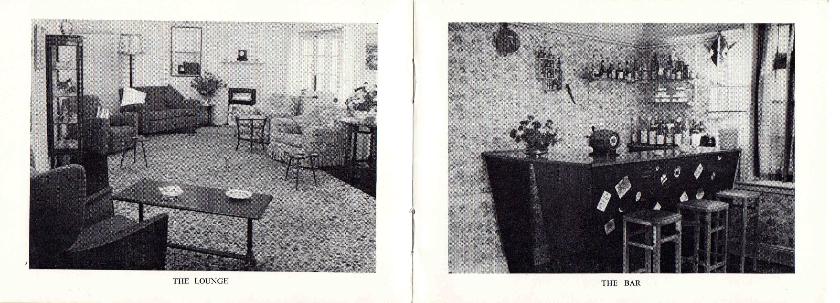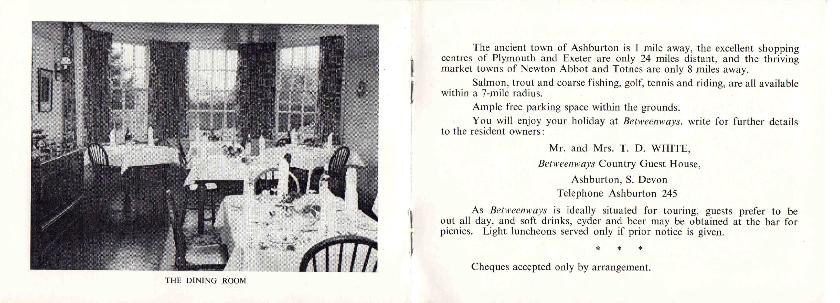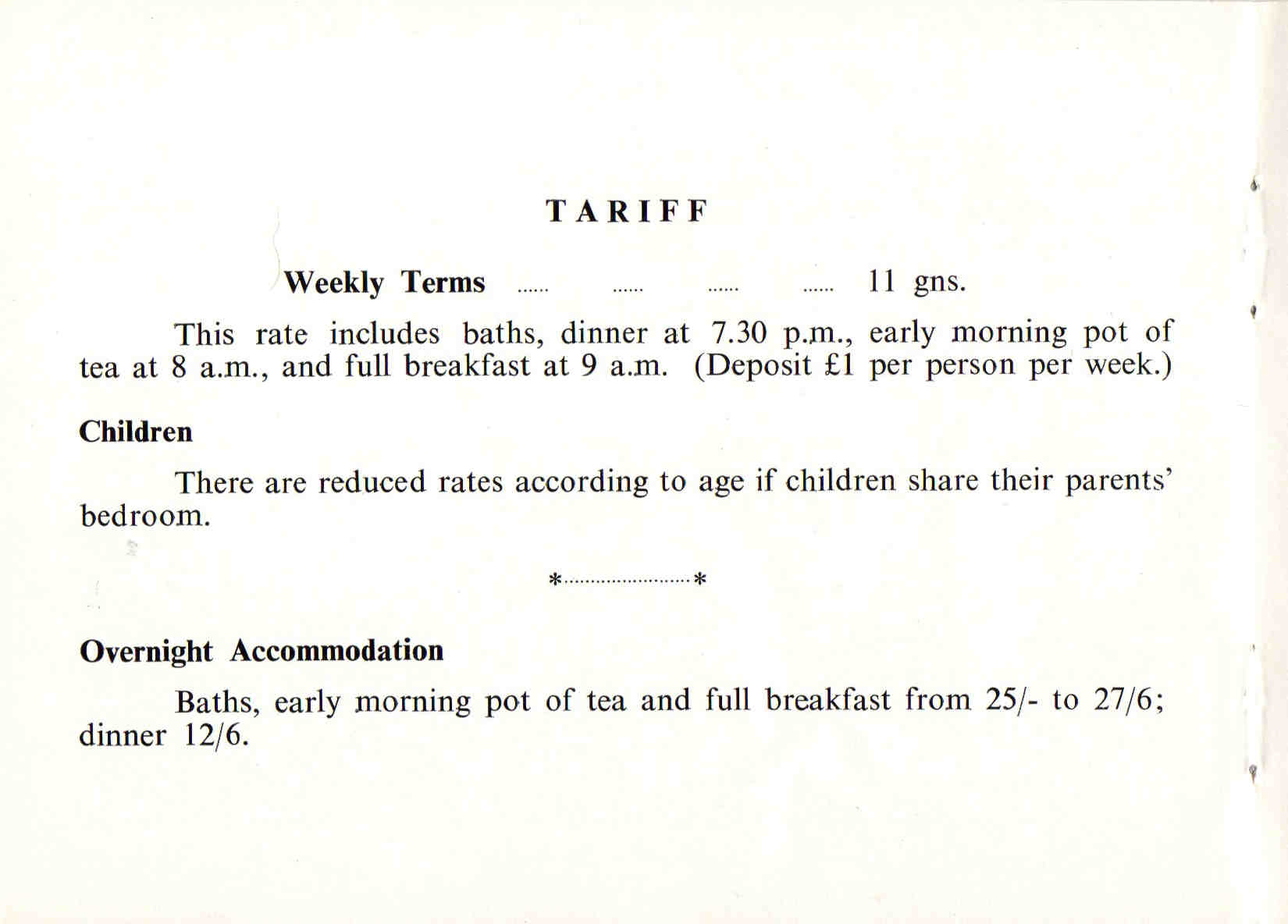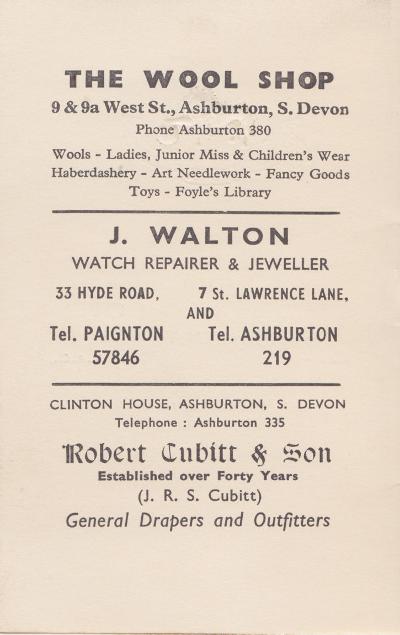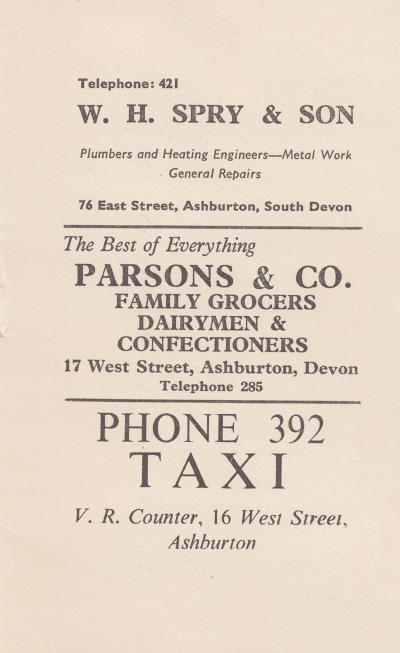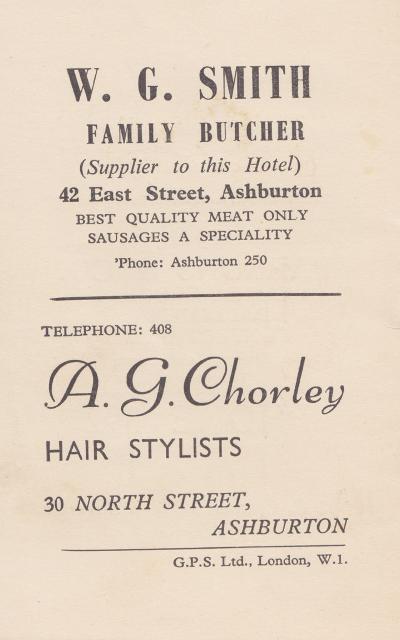* Occupations 1900s *
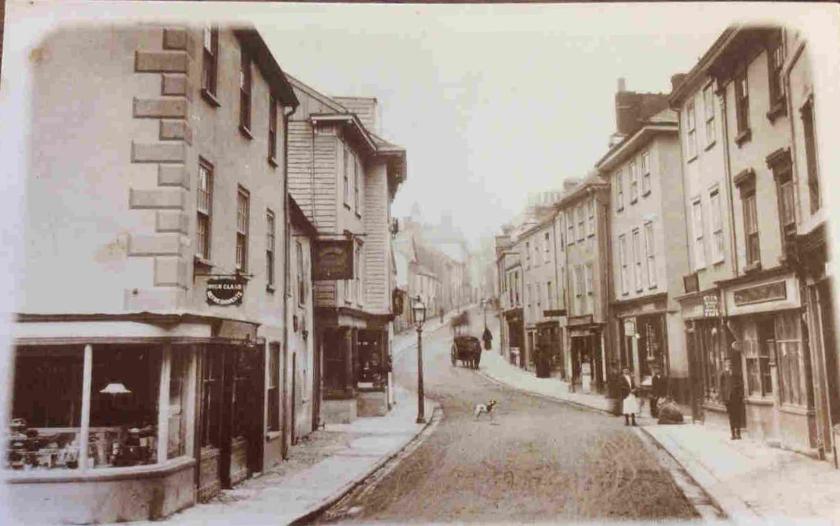
Many thanks to Tereena Ravenscroft for this photograph
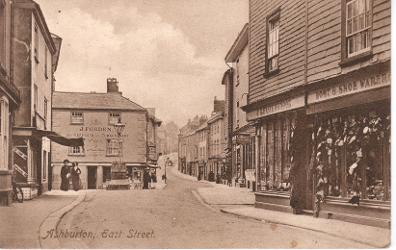
From my own collection
In 1911 James Fogden, assisted by his wife Avis, is a tobacconist and hairdresser at 2 North St. They were living in Portsmouth in 1901.
1911 census RG14, Piece: 12727, Schedule Number: 127
James Fogden is in North Street* in Kelly's Directory of 1914, under Hair dressers.
Kelly's Directory of Devon & Cornwall, 1914 [Part 2. Devon: Private Resident & Trade Directories] p1082
*The building in the picture is on the corner of East Street and North Street.
The shop on the right hand side of the picture (No 9 West St) has J H Easterbrook written above it, plus Boot and Shoe Warehouse (probably).
The 1911 census has John Henry Easterbrook living at Haytor House, West St., with his wife Nellie Mary. He is a tailor outfitter and boot dealer.
1911 census RG14, Piece 12725, Schedule Number 110
J H Easterbrook is in West Street in Kelly's Directory of 1914, under Boot and Shoe makers and dealers.
Kelly's Directory of Devon & Cornwall, 1914 [Part 2. Devon: Private Resident & Trade Directories] p960
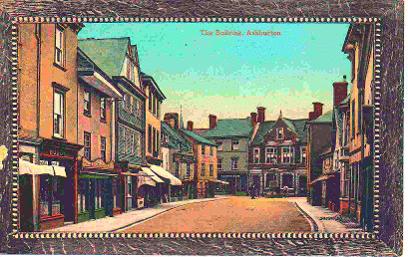
In the 1901 census William Henry Huddy was a grocer in East St., with the elder of his two sons, 17 year old William Thomas Huddy, an apprentice.
He is still in East St in 1911 - see the People and properties section.
From my own collection.
The item on William Henry Hutchings has now moved to the Hutchings family, under Individual families
* Businesses in the 1920s and 30s *
From Hazel Bray:
East Street
There were two ironmongers (hardware stores) and two saddlers’ shops, one of them, Charlie Eales, was situated in the centre of town next to Lloyds Bank (No 2 East St).
There were numerous shops in the town: grocery shops were fascinating. Next to Andrews the baker was Mr Tape’s grocery shop - Mr Tape was a gentleman of rotund proportions who sang in the church choir. Mr Tape and Mr Edgecombe, the post master, changed their garb on Sundays for surplus and cassock, their deep voices and dignified bearing adding to the respect they already earned as businessmen.
Between the Royal Oak and Andrews the baker was the Star Supply Store, but self respecting housewives scorned this modern innovation. Butter was cut from a large rectangular block, and butter pats shaped it into a perfect rectangle and embellished it with a final slap on top, leaving a cow, floral pattern or some other rural reminder of its origins. My mother was horrified when I suggested that we had butter with a cow on top, “We eat Stanbury’s from Summerhill Farm, not that New Zealand stuff!” she replied.
A printer’s shop occupied a site opposite Tape the grocer in East Street and higher up was a butcher’s. It was the practice for animals to be slaughtered by the butcher or a man employed for this purpose in the field now occupied by the new primary school which was used for rearing pigs. Here once a week the horrific agonising sounds of pigs being killed was distressing to small children. Farmers’ sons adopted a pragmatic approach and one was heard to remark “You likes bacon, dowt ee”.
There were several butchers’ shops. Beside the usual beef, pork and lamb a variety of offal was sold. Liver, kidneys, hogs pudding and chitterlings, brains and the may bag, which, I believe was the animal’s stomach. Tripe was also on display, honeycomb and black being two of the varieties. Pigs’ trotters were popular and strings of sausages hung from hooks as well as pigs’ heads, tripe and rabbits. Poultry was rare; it was considered a luxury and reserved for Christmas when feathered geese, ducks and chicken hung outside the shop well above the reach of passersby. Turkeys were considered beyond the pocket of ordinary people and were not usually in evidence, although gleenies, the local name for guinea fowl, and pheasants and geese were also popular.
Above the butcher was a haberdashers and wool shop, run by Mrs Mugridge, a short stout woman who appeared with a broad smile to greet her customers. Her husband worked as a postman, a tall broad shouldered man who dwarfed his wife. To me they appeared to have stepped straight out of one of Dicken’s novels. Mr Mugridge was known locally as ‘Billy Mug'.
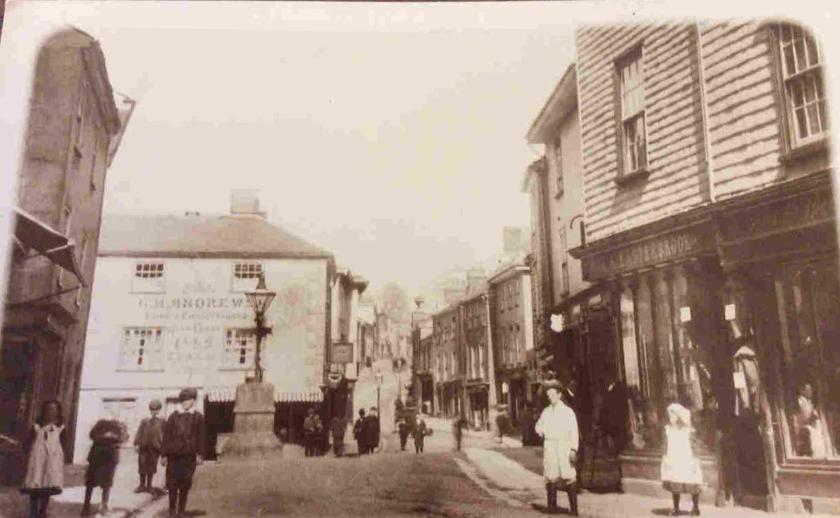
Many thanks to Tereena Ravenscroft for this photograph
Higher up on
the opposite side was Sam Eales' establishment. He must have sold other
goods, but as far as I know he was the provider of paraffin. This was
ordered on a Friday and to go into the little low ceilinged store was
like entering a cave. It was dark and smelt of oil and age. The owner
had an extremely red complexion. He delivered the paraffin on a Saturday
morning in a rundown van and the oil was poured into the housewife's
can from a tap on the door of the van. A funnel was placed in the can
and woe betide him if he spilt any oil of the freshly washed pavement. I
watched hoping for some spillage as the complaints from the housewives
fascinated me. Some people still used oil lamps, though gas was
considered to be the ultimate modern form of lighting. Paraffin fuelled
Valour stoves which heated many bedrooms, including our own, in winter
casting fascinating patterns on the ceiling. The next morning the
windows bore evidence of Jack Frost's visit during the night. Delightful
pictures appeared as if by magic.
Almost opposite Greylands (48 East St)
was Miss Knapman's shop. Mrs Knapman sold sweets and a small assortment
of groceries in her front room, not uncommon in the twenties.
***
St Lawrence Lane
Almost opposite the Post Office in Station Road, now St Lawrence Lane, was a little grocery store run by Mrs Bessie Daw. She had inherited this from her mother, so it was a well-established business; she specialised in cheese. The shelves were well stocked with goods - Vinolia soap jostled with carbolic soap and bags of washing soda. Sides of bacon hung from hooks in the ceiling and many an unwary customer received a clout on the head. Tins of salmon stood alongside canned fruit, jams and pickles. Sacks of sugar stood on the floor together with dried fruit and the dreaded prunes, which we children hated. On a round table, in pride of place was a huge Cheddar Cheese, a speciality of the store. Wire cutters resided on top and a large triangular wedge would be carefully wrapped and weighed on brass scales with shiny polished weights, which ranged from a large two pound weight to a tiny one gram. A wire basket containing eggs was in the window. Eggs and butter fluctuated in price weekly according to Newton Market prices.
North Street
There were thirteen public houses in the town in the twenties: 'As many as in Paignton', my father remarked. He was a naval pensioner and frequented the Sun Inn, known locally as the Sailors' pub. The landlord was an ex-sailor, the father of Minnie and Mabel Butler, two maiden ladies well known for their regular churchgoing. At night Minnie would play the piano in her father's inn and the men would enjoy a singsong, but at the sound of the bell and "time" she would quietly say, 'Now we will all stand and sing the sailors' hymn' and the enthusiasm was undeniable as their voices were raised in the rendering of 'Eternal Father, strong to save.'
There
were shops in the lower part of North Street. Two large draper's shops:
Osborne's next to the Paper Shop and Cubit's. Osborne's stocked clothes
and household items. Bentwood chairs with long legs stood by the
counter, and restless and unruly children were planted on the chair
while the proprietor, a small spruce man, served his customer. Mr
Osborne had two daughters, Ella and Madeline, who were considered to be
young ladies and would have considered it demeaning to serve in their
father's shop. One however was Brown Owl of the local Brownie pack.
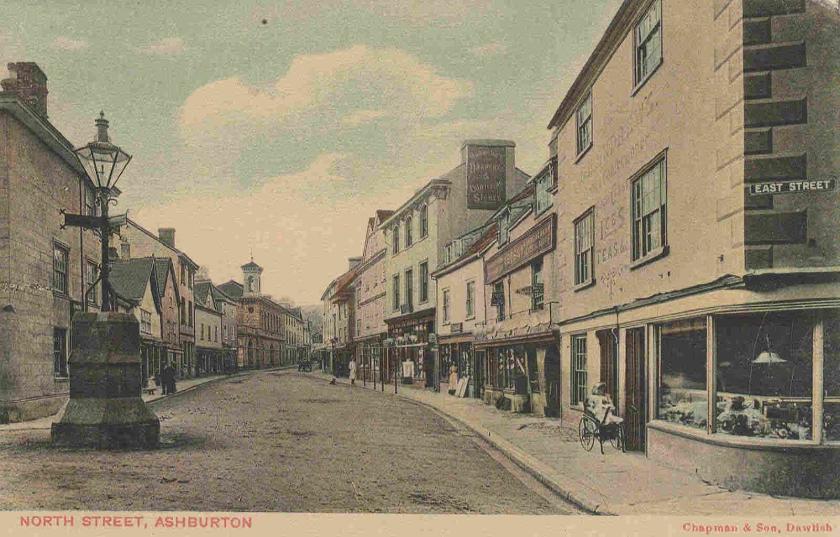
Below: A view further up North Street.
From my own collection
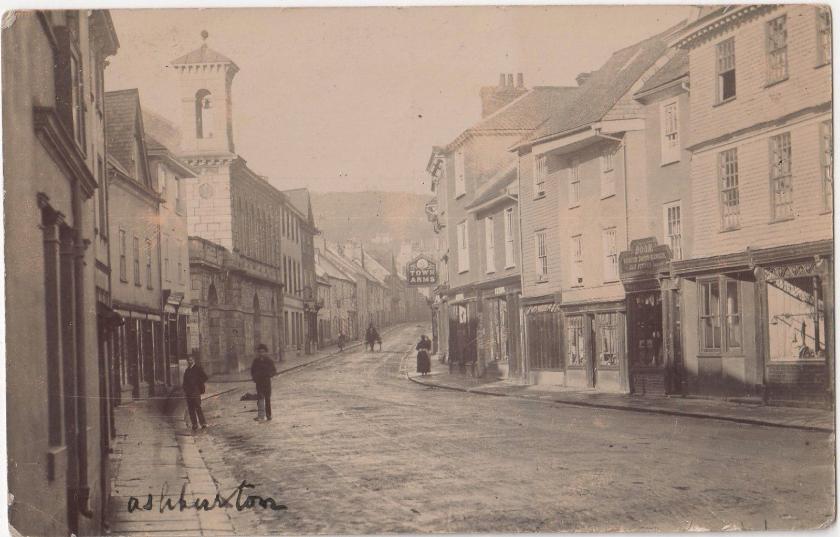
Boon’s the hardware shop was a fascinating place for men to browse in.* Low ceilinged and dark, it supplied all the requirements for the handyman. Further up North Street was another hardware shop and another saddler’s shop.
On the opposite side by Kingsbridge Lane was Bonstows Dairy selling butter, eggs and cream. A large bowl of clotted cream held pride of place in the window. Customers took a bowl or glass dish; this was weighed and then the required amount of the delectable product was carefully measured. A piece of greaseproof paper was placed over the top. All the produce was from local farmers, customers always wanted to know the source of their goods.
At the top of North Street on Great Bridge, Harold Hatch worked in the wheelwright’s premises. Water was readily available for immersing the wheels, and the age old craft provided interest for passersby. He was a tall slim man, meticulously tidy and his premises were a treasure trove of the tools of his trade. They hung on walls and were a museum of his craft. With his demise everything disappeared. For some years, it became a garage and filling station.
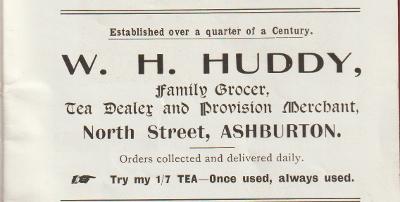
Grocery assistants weighed produce and deftly closed the tops of the blue bags securely, and at Down and Beers fancy biscuits were displayed in glass cases - you selected your favourites which were then put in a bag and weighed – the world of supermarkets and packaged goods undreamt of. Down and Beer and Mr Huddy went to the chapel 'dissenters' as my mother persisted in calling them.
Many thanks to Hazel Bray for the account above.
* This was almost certainly Horace Boon. On the 1921 census he was an ironmonger and painter in North Street. His wife Sophia assisted in the business; they had two children, both of whom had been born in Ashburton.
1921 census RG15, piece no. 10435, schedule 92
His funeral was reported in 1929 . Described as highly respected, he had been in business up until about 1926. A Wesleyan, he had been a Sunday school teacher and at one time a member of the Fire Brigade.
Western Times 3 May 1929 p10 col3
Western Morning News 7 July 1923 p8 col5
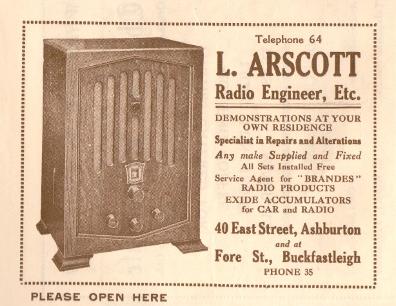
At the time of the 1911 census he was 27 years old, living with his parents in Buckfastleigh. He was a builder's clerk.
Western Times 3 February 1905 p12 col5
1911 census RG14, piece no 12838
In 1927 Lewis Arscott gave evidence after two cars collided in Ashburton. He was described as an engineer.
Exeter and Plymouth Gazette 16 September 1927 p7 col7
Exeter and Plymouth Gazette 25 March 1937 p8 col1
See his advertisement below
*******
Itinerant traders in the 1920s
The rag and bone man made regular visits, much to the delight of the children – a bundle of old clothes would be exchanged for a goldfish, or maybe two, the recipient having produced a jamjar of water. Some poor fish were killed with kindness, but others lived for a year or so, and proud owners of a goldfish bowl displayed the fish forever circling the confines of its globe. Eventually someone deemed these bowls not suitable for the fish to swim in, so tanks became substitutes: hopefully goldfish appreciated the change.
Welcome itinerant traders were the French onion boys, who came annually to the town. In their distinctive striped jumpers and familiar berets, they arrived on bicycles with the string of onions hung in a picturesque style over the handlebars. They spoke little English and local people had no knowledge of French, but transactions were made and many kitchens proudly displayed their onions from Brittany, dwindling week by week.
A knife sharpener would appear periodically pushing a trolley and working a wheel which caused a circular stone to revolve. Knives and scissors were produced and the skilled hands of the operator would thumb the blade to be sure he'd done a good job.
On summer evenings, vans would appear from Torquay or other seaside towns selling mackerel. The men called out loudly 'Fresh fish, five for a shilling!' Sometimes the cry would be 'Little Joeys, tuppence each!'
Many thanks to Hazel Bray for the account above.
*******
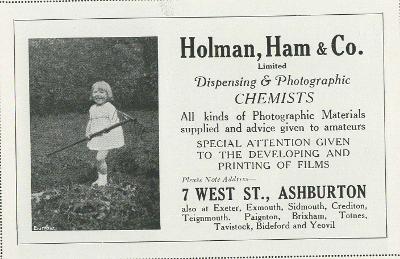
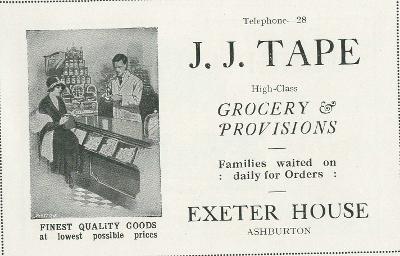
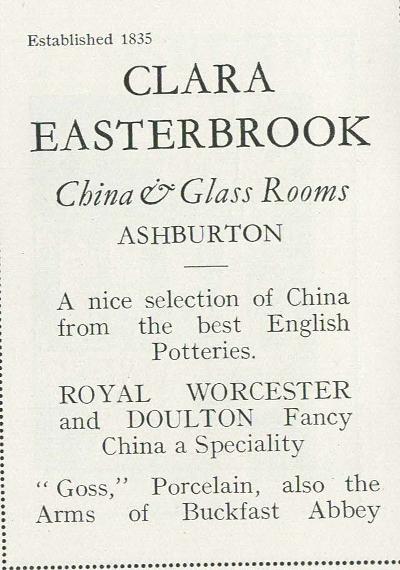
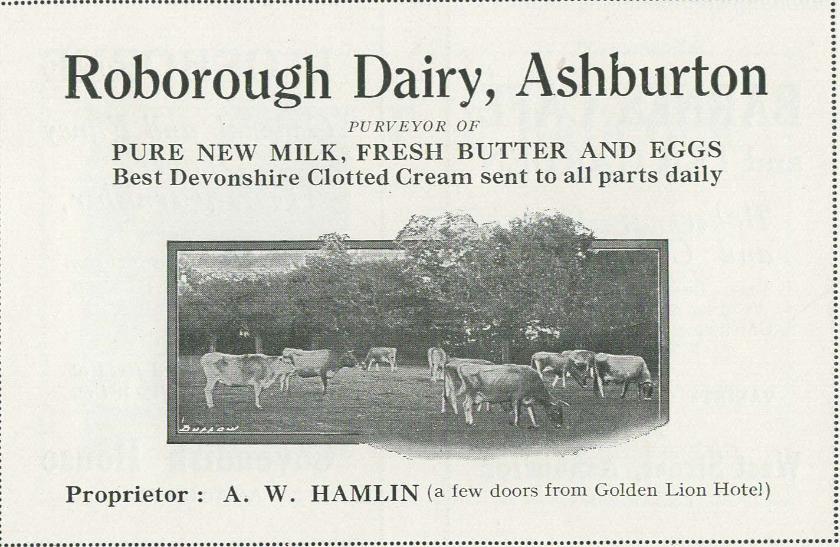
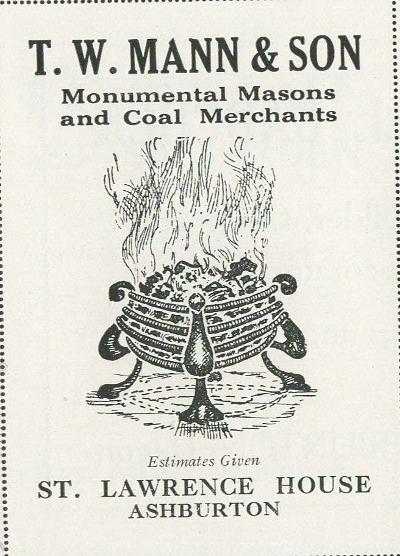
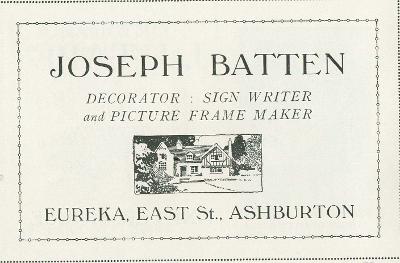
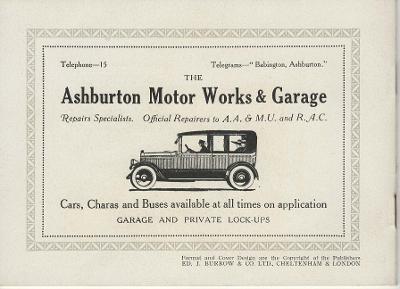
Ashburton Urban District Council, undated, but between 1930 and 1935
London Hotel, proprietor J F Lamb
Rendell and Sawdye, auctioneers, surveyors, valuers and estate agents, West St
Sly's Dairy and Cafe, 17 West St
Ashburton Motor Works and Garage, proprietor E O Babbington
The Card House Cafe, 'originally an old gambling den', proprietor G Kirby
Newsagent, M Langler, 6 North St
Barnes' Cafe (est 1780) West St
L Arscott, Radio engineer, 40 East St
Golden Lion Hotel
Lurgecombe Farm, Mrs Villis
Kingsley Hotel, adjoining main road Exeter and Plymouth
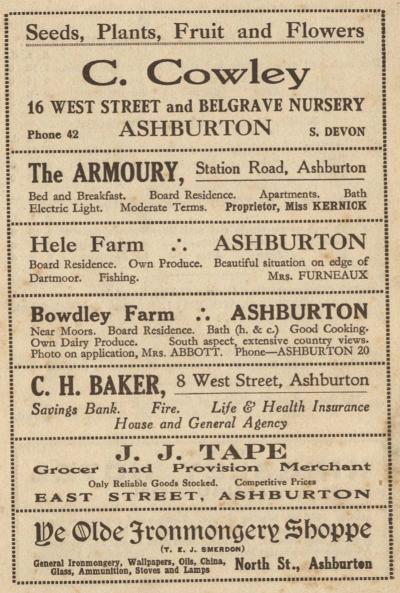
The Armoury, Station Road, board residence, B & B, proprietor Miss Kernick
Hele Farm, Mrs Furneaux, board residence
Bowdley Farm, Mrs Abbott, board residence
C H Baker, 8 West St, Savings Bank, Insurance Agency.
J J Tape, Grocer and provision merchant, East St
Ye Olde Ironmongery Shoppe, T E J Smerdon, North St.
Ashburton High School for Girls, headmistress Miss Margaret J Sharkie
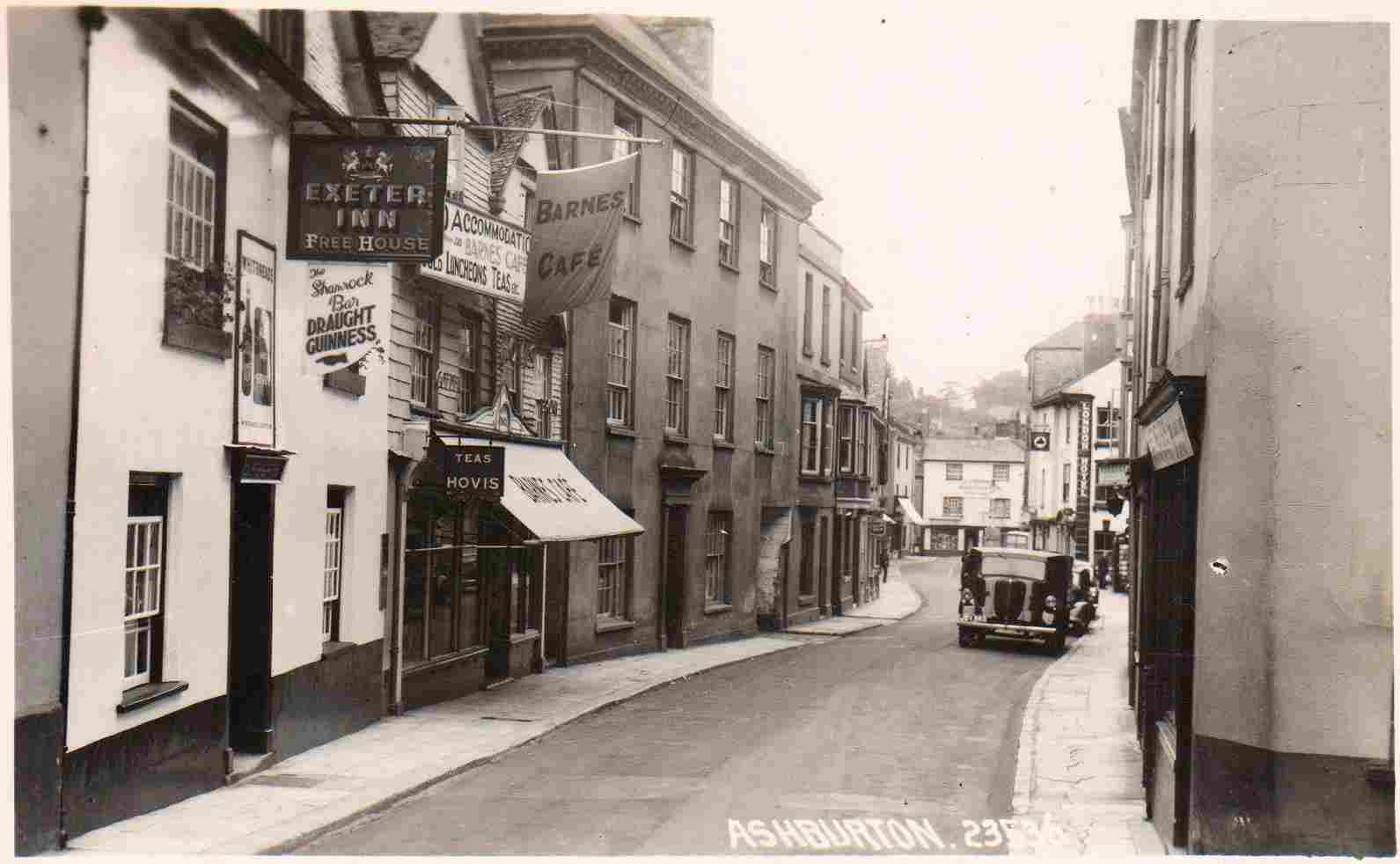
From my own collection
*******
Western Times 6 October 1939 p8 col1
*******
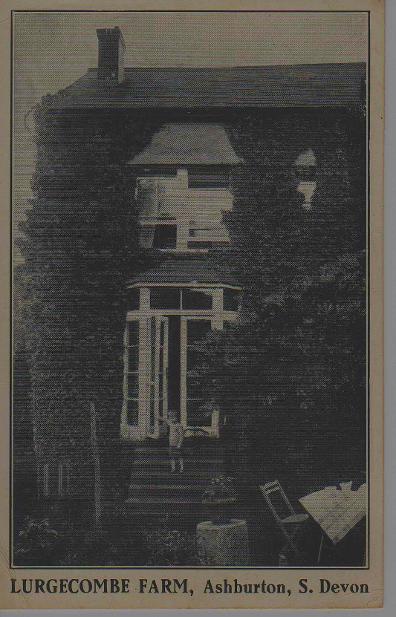
Left and below: A postcard advertising Lurgecombe Farm, owned by Mrs. Hetty M. Villis. The phone book from at least 1942 onwards confirms the telephone number as 266.
http://www.ancestry.co.uk
From my own collection
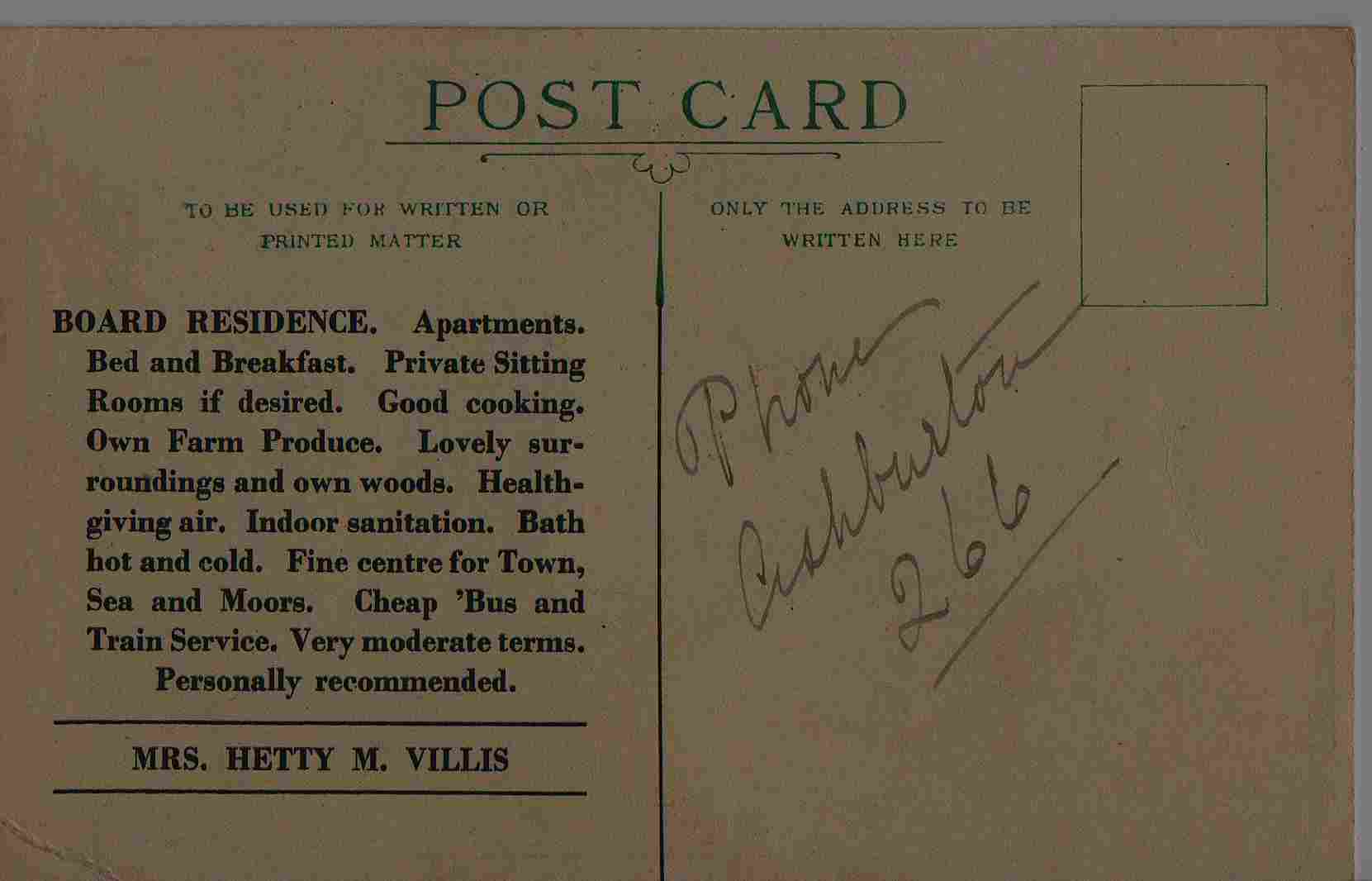
Hetty died in the March quarter of 1956, aged 87, in the Newton Abbot registration district.
http://www.freebmd.org.uk/
In
1948 a fire occurred at the Pear Tree Cross Cafe, owned by Mr and Mrs G
A Pearse. A motorist spotted flames in the thatched roof, and a 'fresh
breeze' enabled the fire to take hold. In spite of the efforts of the
Ashburton and Newton Abbot brigades, the cafe was completely destroyed.
Many residents and motorists helped salvage furniture and goods from the
building.
Exeter and Plymouth Gazette 21 May 1948 p6 col2
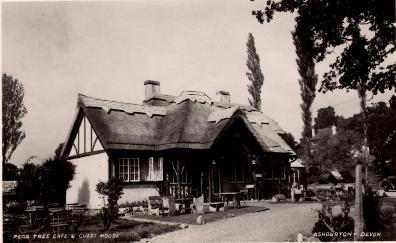
*******
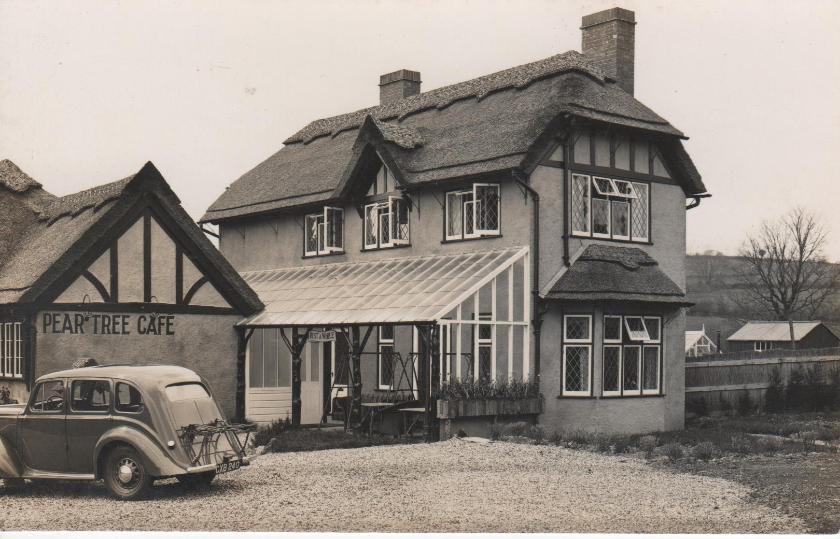
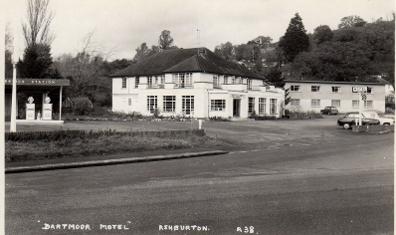
Left: The motel, rebuilt on the site.
Both from my own collection
The item on Webbers and Christophers has now moved to Building Contractors, under Banks and Businesses.
In 1955, the Co-op had departments at nos. 8,19, 30 and 32 North St. The drapery department was at no 8, and the regional office was at no 19.
See item in the 1950s section of the Virtual museum
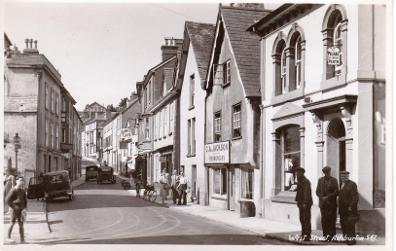
Left: West Street, 1940s or 50s ?
The property second from the right, No.12, has the sign C A Jackson, Fishmongers. Further up on the right the sign protruding from the building says Barnes Café.
From my own collection
Ashburton Motor Works Ltd., Town centre. Tel Ashburton 215
H R Manley, Builder and civil engineer. Hannaford Court. Tel Ashurton 419
J Walton, Crested ware, jewellery, watch repairs, souvenirs. 7 St Lawrence Lane, opposite G P O. Phone 219
H J Parnell, High class baker and confectioner. East Street. Phone 365.
Streeton, Newsagent, bookseller, stationer. North Street.
Bolloms dry cleaning. 22 North Street.
Ernest Owen, Quality confectioner. 9 East Street
Sawdye and Harris, Auctioneers, agricultural valuers and surveyors, estate agents. Tel 304. Monthly sales of all stock at Ashburton market.
Right: Page from the Golden Lion booklet.
See the Virtual museum 1950s section for more images.
From my own collection
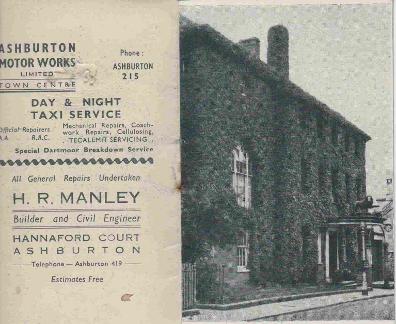
Businesses advertising in the Official Guide of Ashburton
Ashburton Urban District Council, undated, but between 1952 and 1960
E A Horrell, Decorator, grainer, signwriter etc
Ashburton Motor Works
D & E Milton, Greengrocery, 34 East St
A H Lang, Baker, 33 North St
S J Elson, Printers and stationers, The Printing Works, Ashburton
Bollom, Dry cleaners and dyers, 22 North St
G Arscott, Grocers and general stores
A J Kerslake, Family and dispensing chemist. 44 East St
Eagle Dairy, Milk, cream, general grocers, tobacco etc., East St
The Wool Shop, Ladies' and childrens' wear, toys, Foyle's library, 9 and 9a West St
E M Morey, China and glassware, Devonshire pottery, 27 West St
M J Mann, Radio and electrical engineer, 3 West St
Slade and sons, 'the good old fashioned grocers!', est 1837, the Grocers of London House, Ashburton
Kenneth E Ruth, Commercial photographer, 12 West St
Webber and Christophers, Builders, decorators, funeral directors, 26 St Lawrence Lane
Walton's, jewellers, souvenirs, trinkets, 7 St Lawrence Lane (also 33 Hyde Road, Paignton)
A R Church, Ironmongers, North St
Robert Cubitt and son, General drapers and outfitters, 'Clinton House'
Osborn's, Grocers, 16 North St
G H Farley, Radio, television and electrical
Co-op, Groceries, drapery, bread and confectionery, boots and shoes, North St
C H Churchward, Grocer, fruiterer, florist, The Sun Stores, North St
A J Braund, The Paper Shop, Newspapers, stationery, tobacco and confectionery, 6 North St
G B Soper, Butcher, 42 East St
Parsons and Co., Grocer, dairymen and confeectioners, 17 West St
Holman, Ham and Co., Family and dispensing chemists, West St
Bakery & Confectionery Products Ltd., Ernest Owen, 9 and 57 East St
Studio Theatre, Ashburton
Exeter House, Proprietress Mrs Jennings
The Golden Lion Hotel
H B Cook of London, Hair Stylist, 30 North St
Treasure Trove, Mementoes, toys, ice cream, cigarettes, 30 East St, Proprietor A L Neate (Late of Birmingham)
Belgrave Nursery, I L Grimes, Bowden Hill, with shop 1 East St
Pedrick, Ladies' and children's hairdresser, 22 East St
M & M Butler, Stationery and fancy goods, toys, wools, 14 North St
C H Naylor, Plumber, heating and sanitary engineer, Ladwell, Ashburton
V R Counter, Taxi, West St
Mrs J A Hamlyn, Bed and breakfast, evening meal, Westabrook Farm
H J Winter, Caravan and tent sites, caravans to let, Waterleat Farm
Victoria Inn
Mrs Furneaux, Board residence, 29 East St
Royal Oak Inn
F W Cannon, Farmhouse fare, Yolland Hill Farm
Exeter House Cafe (opposite Midland Bank), East St
Jack's Snack Bar, 17 East St
The Green Gazelle, Teas and morning coffee, Devon pottery and curios
Barnes' Cafe and tea Gardens (opposite the church)
Frisby's, Footwear, East St
Gayton's Luxury Coaches
Sawdye and Harris, Auctioneers, surveyors, land agents etc., J A Sawdye and C H Harris
Edwin Tucker & Sons Ltd.,incorporating Hamlin and Whiteway Ltd., and Durant and Sons, Seed merchants, maltsters, agricultural merchants
The Eastern Garage, Automobile and general engineers
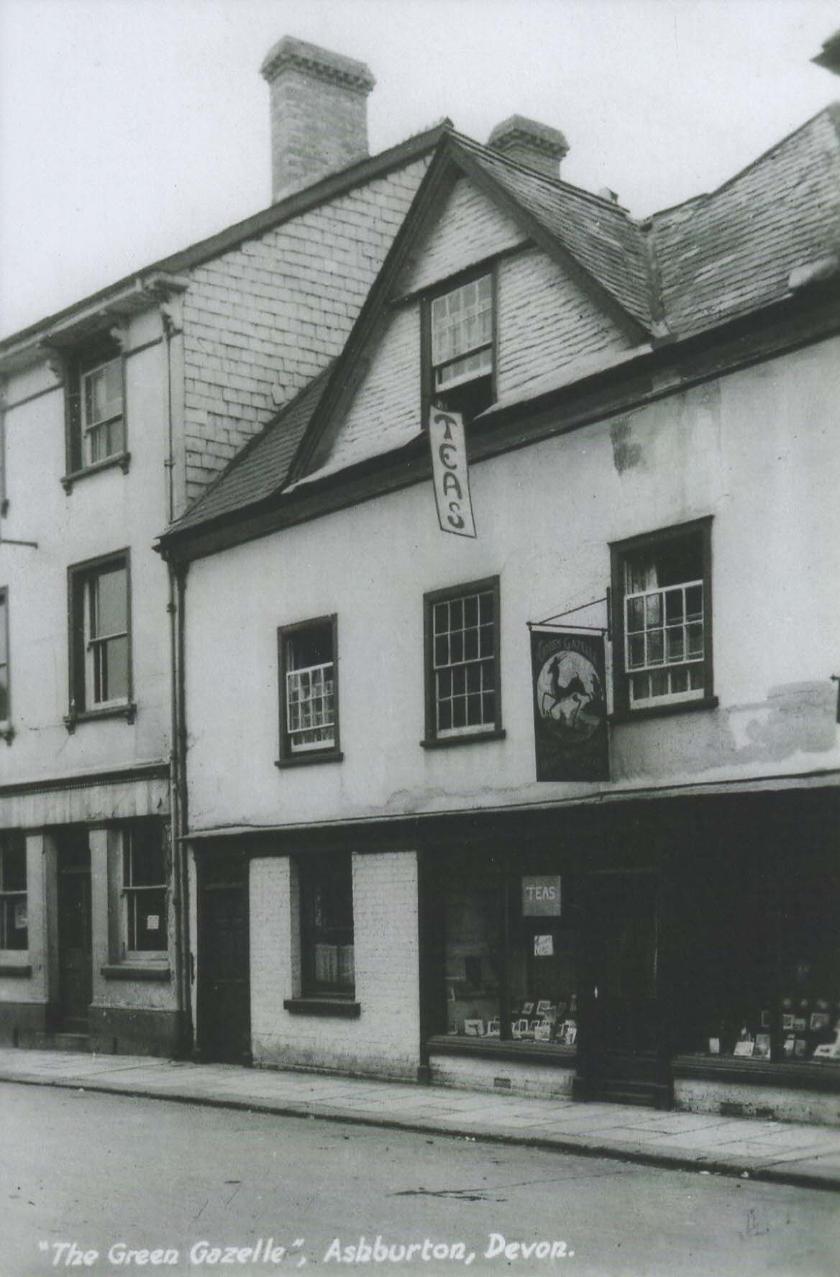
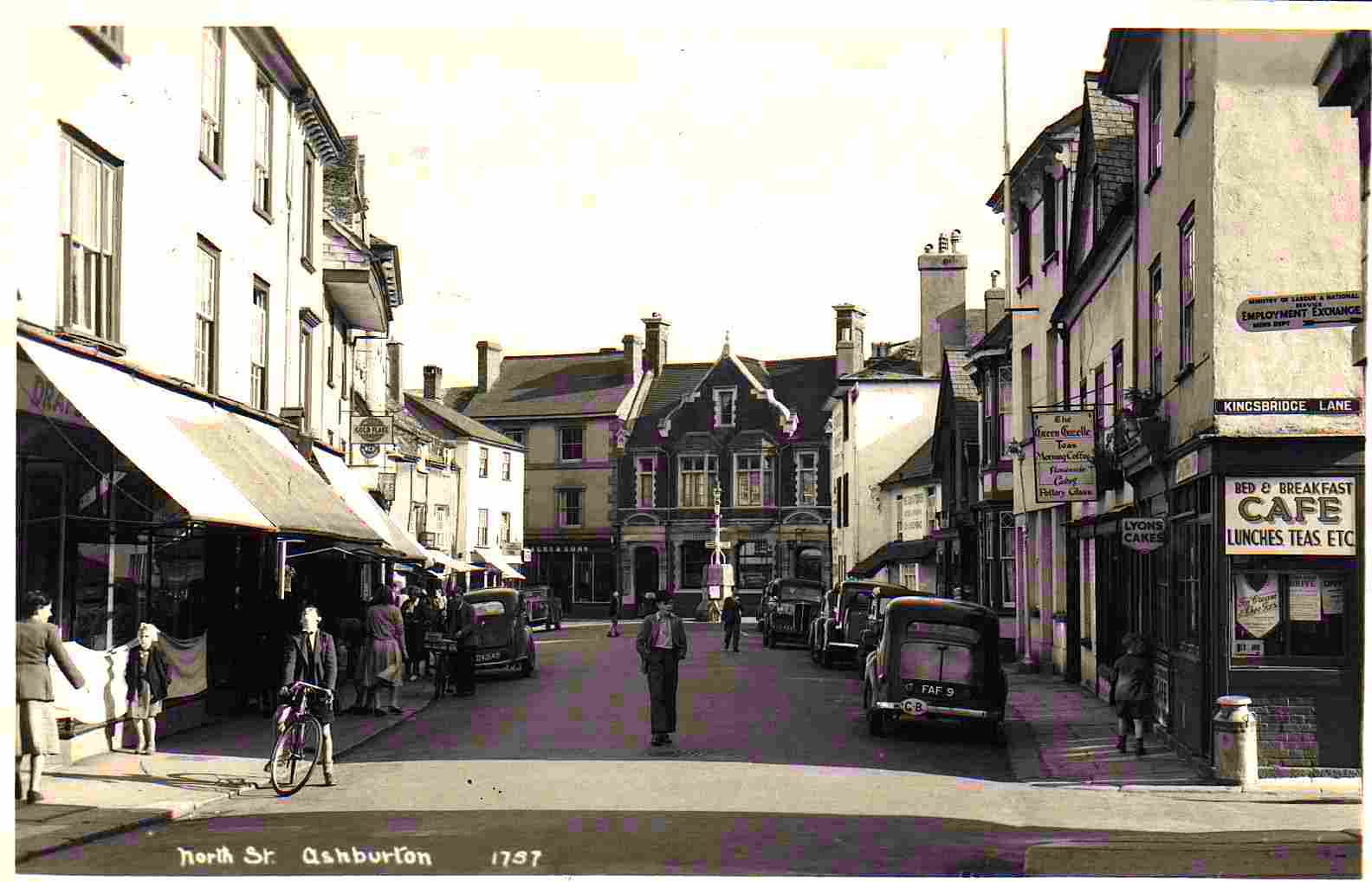
Above: The Green Gazelle Café
Left: North Street, the 1950s. The Green Gazelle Café is on the right hand side of the photograph, (with a protruding sign), the next one along from the café on the corner with Kingsbridge Lane.
From my own collection.
The item on Webbers and Christophers has now moved to Building Contractors, a sub-menu of Banks and Businesses.
*******
Betweenways
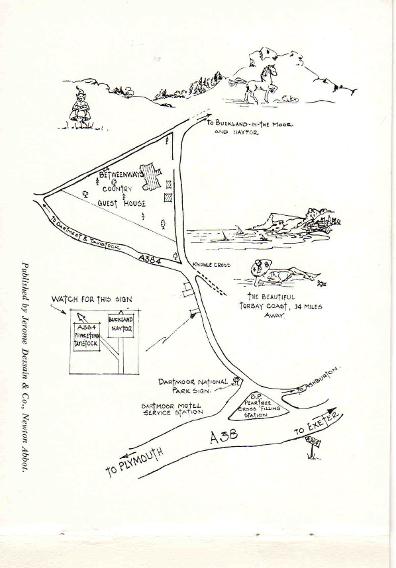
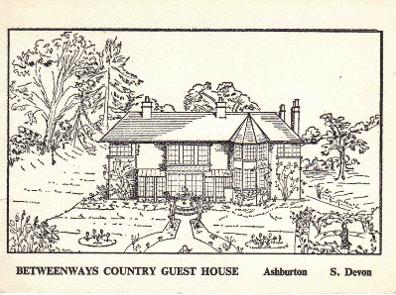
Betweenways, the home of the Foaden family in 1938 and before*, was a county guest house by about the 1960s. Mr and Mrs T D White were running it at the time of this booklet.
Later it was renamed the Grasshopper (1970s - my own recollection); later still Lanterns. It is now (2016) the Lavender House Hotel.
*See Indiviual Families.
The booklet illustrated is from my own collection
